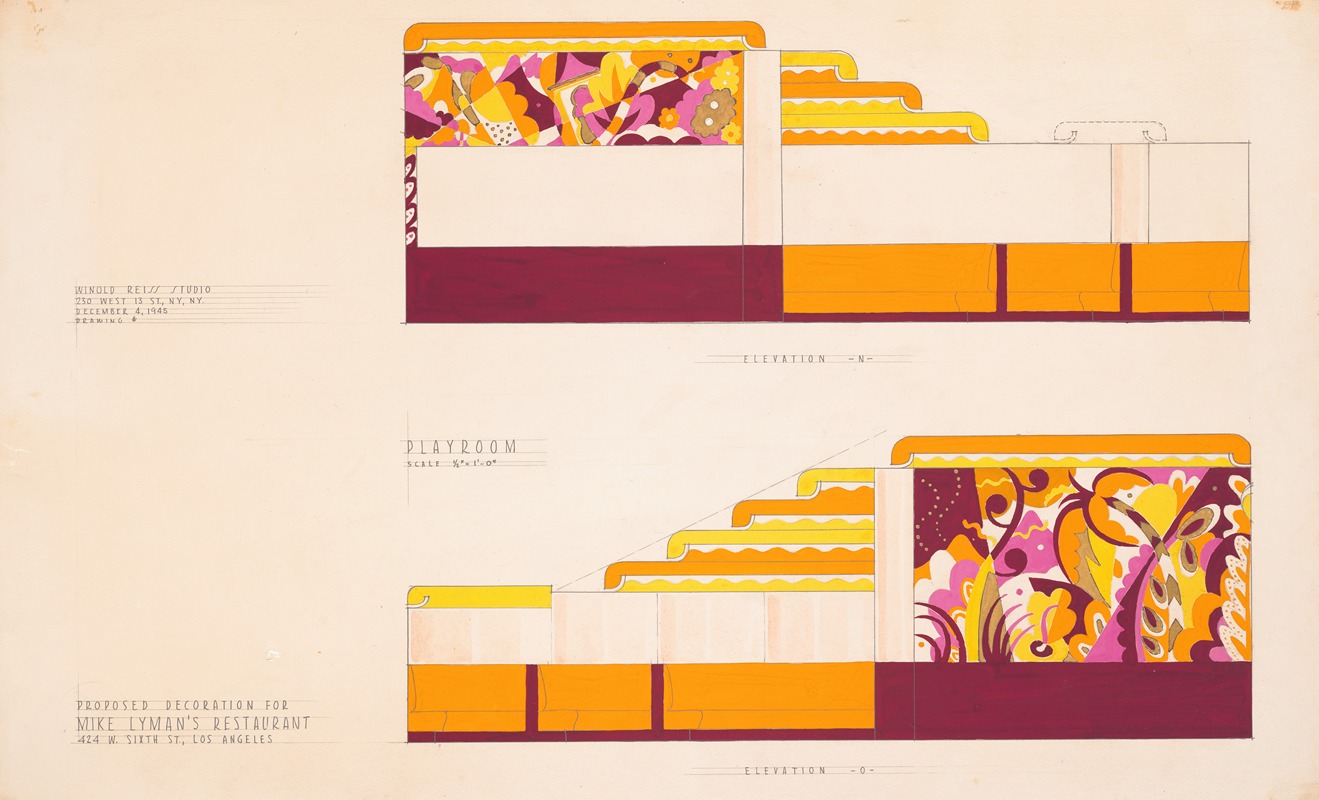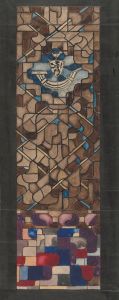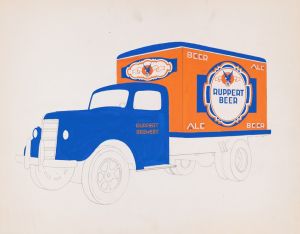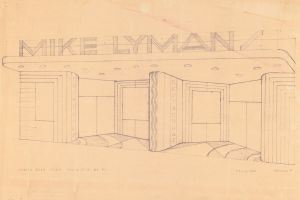
Drawings for proposed decorations of Mike Lyman’s Restaurant, 424 W. Sixth St., Los Angeles, CA.] [Drawing #8, playroom elevation N and O
A hand-painted replica of Winold Reiss’s masterpiece Drawings for proposed decorations of Mike Lyman’s Restaurant, 424 W. Sixth St., Los Angeles, CA.] [Drawing #8, playroom elevation N and O, meticulously crafted by professional artists to capture the true essence of the original. Each piece is created with museum-quality canvas and rare mineral pigments, carefully painted by experienced artists with delicate brushstrokes and rich, layered colors to perfectly recreate the texture of the original artwork. Unlike machine-printed reproductions, this hand-painted version brings the painting to life, infused with the artist’s emotions and skill in every stroke. Whether for personal collection or home decoration, it instantly elevates the artistic atmosphere of any space.
Winold Reiss was a German-American artist known for his work in interior design and his vibrant portrayals of diverse American cultures. Among his many projects, Reiss contributed to the design of Mike Lyman’s Restaurant, located at 424 W. Sixth St., Los Angeles, California. This particular establishment was part of a chain of restaurants owned by Mike Lyman, a notable figure in the Los Angeles dining scene during the mid-20th century.
The drawing titled "Drawings for proposed decorations of Mike Lyman’s Restaurant, 424 W. Sixth St., Los Angeles, CA. Drawing #8, playroom elevation N and O" is one of several conceptual designs created by Reiss for the restaurant. This specific drawing focuses on the playroom area, highlighting elevations N and O. The playroom was likely intended to provide a family-friendly environment within the restaurant, a feature that was becoming increasingly popular in dining establishments during that era.
Winold Reiss's approach to design was characterized by his use of bold colors and geometric patterns, often incorporating elements that reflected the cultural diversity of the United States. His work in Mike Lyman’s Restaurant would have been no exception, as Reiss was known for creating spaces that were both visually striking and culturally resonant. Although specific details about the motifs or themes used in the playroom elevations N and O are not available, it can be inferred that Reiss's design would have aimed to create an engaging and dynamic atmosphere for patrons.
Mike Lyman’s Restaurant was part of a larger trend in Los Angeles during the mid-20th century, where dining establishments began to emphasize not only food but also the overall dining experience. This included innovative interior designs, thematic decorations, and spaces that catered to a wide range of customers, including families with children. The inclusion of a playroom in the restaurant reflects this shift towards creating more inclusive and versatile dining environments.
Reiss's involvement in the project underscores his reputation as a versatile artist capable of adapting his style to suit various commercial and cultural contexts. His work in interior design, particularly in public spaces like restaurants, contributed to the evolving landscape of American dining culture during the 20th century. While specific records of the completed playroom design at Mike Lyman’s Restaurant may not be extensively documented, Reiss's influence on the project is a testament to his skill in merging artistic vision with functional design.
Overall, Winold Reiss's contribution to Mike Lyman’s Restaurant represents a fascinating intersection of art, culture, and commerce, reflecting broader trends in American society at the time. His designs for the restaurant, including the playroom elevations, would have played a role in shaping the dining experience for patrons, leaving a lasting impression through his distinctive artistic style.






![Graphic design for cover of Survey Graphic Magazine; ‘Food’.] [Design with text and food items](/imgs/249248/s/winold-reiss-graphic-design-for-cover-of-survey-graphic-magazine-food-design-with-text-and-food-items-877075df.jpg)
![Design drawings for Community Coffee Shops, Wilkes-Barre, PA.] [Proposed wall treatment, interior elevation color study with bosky murals](/imgs/249275/s/winold-reiss-design-drawings-for-community-coffee-shops-wilkesbarre-pa-proposed-wall-treatment-interior-elevation-color-study-with-bosky-murals-1ff2a82a.jpg)
![Designs for staged commercial or trade exhibition displays of coal-fired water heaters and furniture.] [Perspective sketch featuring flames](/imgs/249323/s/winold-reiss-designs-for-staged-commercial-or-trade-exhibition-displays-of-coalfired-water-heaters-and-furniture-perspective-sketch-featuring-flames-367ef0b8.jpg)
![Drawings for proposed decorations of Mike Lyman’s Restaurant, 424 W. Sixth St. Los Angeles, CA.] [Scheme 1; elevation – K – showing bar](/imgs/249336/s/winold-reiss-drawings-for-proposed-decorations-of-mike-lymans-restaurant-424-w-sixth-st-los-angeles-ca-scheme-1-elevation-k-showing-bar-6d934644.jpg)
![Drawings for proposed decorations of Mike Lyman’s Restaurant, 424 W. Sixth St., Los Angeles, CA.] [Drawing #7, playroom elevation L and bar elevation M](/imgs/249338/s/winold-reiss-drawings-for-proposed-decorations-of-mike-lymans-restaurant-424-w-sixth-st-los-angeles-ca-drawing-7-playroom-elevation-l-and-bar-elevation-m-f9ee50d2.jpg)
![Drawings for proposed decorations of Mike Lyman’s Restaurant, 424 W. Sixth St., Los Angeles, CA.] [Playroom bar partial elevation, color design sketch with mural](/imgs/249340/s/winold-reiss-drawings-for-proposed-decorations-of-mike-lymans-restaurant-424-w-sixth-st-los-angeles-ca-playroom-bar-partial-elevation-color-design-sketch-with-mural-110bebc4.jpg)
![Graphic design drawings for Barricini Candy packages.] [Study, ‘French Chocolates’ candy box, pink and black](/imgs/249347/s/winold-reiss-graphic-design-drawings-for-barricini-candy-packages-study-french-chocolates-candy-box-pink-and-black-5b35608f.jpg)

![Interior design drawings for unidentified rooms.] [Sketch for interior, possibly hotel lobby](/imgs/249361/s/winold-reiss-interior-design-drawings-for-unidentified-rooms-sketch-for-interior-possibly-hotel-lobby-c271d10.jpg)
![Design sketches for stepped, three-panel, painted decorative folding screens.] [Drawing of plans, elevation, and details](/imgs/249416/s/winold-reiss-design-sketches-for-stepped-threepanel-painted-decorative-folding-screens-drawing-of-plans-elevation-and-details-cebab690.jpg)

